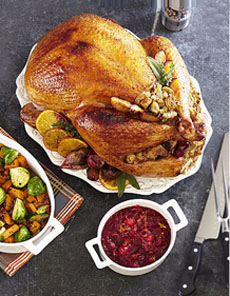TIP OF THE DAY: Make Chicken Or Turkey Stock
|
|
Plan ahead: Don’t throw away that turkey carcass. Or the roast chicken* carcass. Or those tops, root ends and stems from trimming vegetables. Save the vegetable trimmings from the week’s meals: carrot tops, celery ends, fennel fronds, herb stems, kale stalks, leek tops, scallion ends, etc.
Check the freezer for herbs and vegetable scraps you may have tucked away. Use all of it to make a delicious batch of chicken or turkey stock, which you can then turn into cooked grains, sauces, soups, stews and other preparations. RECIPE: CHICKEN STOCK OR TURKEY STOCK Ingredients |
|
|
*Or duck, game hen, quail or any poultry carcass. You can blend them together into one stock as needed. †Check the freezer for herbs and anything else you might have tucked away to prevent spoiling. Preparation 1. COMBINE all the ingredients in a stock pot (6-8 quarts for a turkey, 4-6 quarts for a chicken) and cover them with water plus one inch. If the carcass doesn’t fit in the pot, use poultry shears to cut it into pieces that do. Don’t salt the water; stock should be unsalted to accommodate any recipe. Place the top on the pot. 2. BRING to a boil and reduce the heat to a simmer. Cook for minimum of 90 minutes, or up to 3 hours. Once or twice during the simmering, remove the cover and skim off the frothy scum that’s formed on the top of the broth. Add more water if it boils away; the bones should always be covered. When the broth has turned a golden brown color and is rich in flavor… 3. REMOVE the pot from the heat. As soon as it’s comfortable enough to handle, strain the broth and discard the solids. If it isn’t clear enough for you, strain it again through cheesecloth. 4. FREEZE the chicken broth in portion-sized containers. We like ice cube trays (once frozen, store the cubes in a freezer bag); or in half pint or pint storage containers. If you have a short-term use for it, you can refrigerate the stock for up to a week. |
||
|
USES FOR STOCK Instead Of Water |
 Take pride in your homemade stock. Photo courtesy Good Eggs | San Francisco. |
|
|
THE DIFFERENCE BETWEEN STOCK & BROTH The terms bouillon and broth are used interchangeably, though not correctly. Bouillon is always served plain (with an optional garnish), whereas broth can be made more substantial with the addition of a grain (barley, rice, etc.) and vegetables.
|
||



